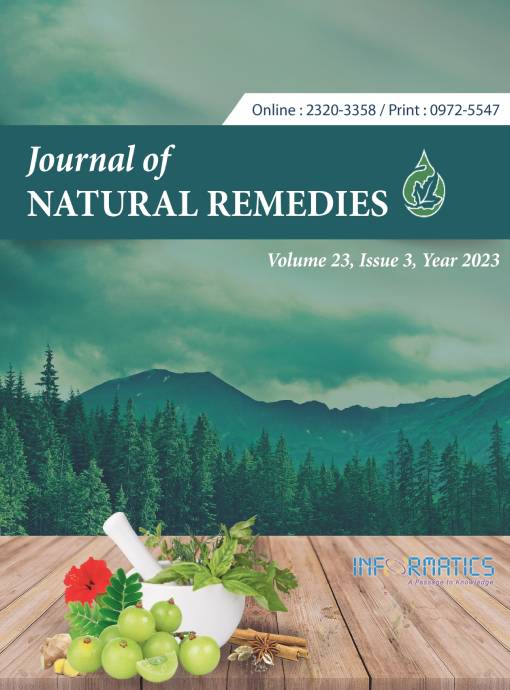Efficacy of Polyherbal Formulation (Phalatrikadi Vati) in the Management of Type 2 Diabetes Mellitus through Metabolic Correction – A Clinical Study
DOI:
https://doi.org/10.18311/jnr/2023/29166Keywords:
Ayurveda, Diabetes Mellitus, Phalatrikadi Vati, Polyherbal FormulationAbstract
Background: Diabetes mellitus is a prevalent metabolic disorder worldwide; its incidents have grown notably in recent years. Over the last 50 years, lifestyle changes have led to a dramatic increase in the prevalence of type 2 diabetes around the world. India has been projected as the diabetic capital of the world. Diabetes and its complications pose a major threat to future public health resources throughout the world and are the major cause of blindness, kidney failure, heart attacks, stroke, and lower limb amputation. In the southern part of India, the mortality rate due to diabetes mellitus is in fifth rank amongst the ten vital causes of death. Despite recent advances in knowledge, preventing and controlling diabetes remain a major challenge. So the present study has focused on the disease pathogenesis and its regulation through Polyherbal formulation (Phalatrikadi Vati). Objectives: To determine the efficacy of Polyherbal formulation in reducing the subjective complaints in Type 2 Diabetes Mellitus by metabolic corrections and thereby controlling the blood glucose level in the body. Methods: A single arm open labeled trial with 1 month in duration. Participants: 25 patients of Diabetes Mellitus Type 2 with diagnosed, high fasting blood sugar and postprandial blood sugar levels. 500mg tablet was given in twice a day after food. Results: A total of 30 patients enrolled in the study and 25 patients completed the treatment. Significant relief of 68% in polyuria, 56% in urine turbidity, 84% in polyphagia, and 76% in polydipsia seen. There was a highly significant reduction in FBS with a mean difference of 31.84 mg and PPBS with a mean difference of 63.92 mg. Conclusion: The polyherbal formulation is a safe intervention and can be expected to reduce the symptoms of Type 2 Diabetes Mellitus and blood sugar levels. Future studies with larger sample sizes, longer duration of intervention and follow up needed for more accurate and reliable results.
Downloads
Metrics
Downloads
Published
How to Cite
Issue
Section
License
Copyright (c) 2022 Vijayalakshmi B Benkatti, Mallamma H Biradar, Jyothy Kothanath Bhaskaran, Srihari Sheshagiri

This work is licensed under a Creative Commons Attribution 4.0 International License.
Accepted 2023-05-03
Published 2023-07-28
References
Tandon Nikhil, Anjana Ranjit M, Mohan Viswanathan, Kaur Tanvir, Afshin Ashkan, Ong Kanyin, Mukhopadhyay Satinath, Thomas Nihal, Bhatia Eesh, Krishnan Anand, Mathur Prashant. The increasing burden of diabetes and variations among the states of India: the Global Burden of Disease Study 1990–2016. The Lancet Global Health. 2018; 6(12):e1352–62. https://doi.org/10.1016/S2214- 109X(18)30387-5 PMid:30219315 DOI: https://doi.org/10.1016/S2214-109X(18)30387-5
Feinglos MN. Type 2 Diabetes Mellitus. Humana press; 2008. p. 13. https://doi.org/10.1007/978-1-60327-043-4 DOI: https://doi.org/10.1007/978-1-60327-043-4
Harsha Mohan. Textbook of Pathology. New Delhi: Jaypee Brothers Medical Publishers; 2005. p. 842.
Harsha Mohan. Textbook of Pathology. New Delhi: Jaypee Brothers Medical Publishers; 2005. p. 843.
Madhava Nidana. Part-2, Chapter 33, Verse 26, edited by Yadunandan Upadhyaya. Varanasi: Chaukhambha Sanskrit Samstan. p. 1.
Agnivesha, Charaka, Dhridhabala, Carakasamhita, Nidana Sthana. Chapter 4, Verse 39, edited by Kasinatha Sastri. Varanasi: Chaukhambha Bharati Academy; 2001. p. 638.
Madhava Nidana. Part-2, Chapter 33, Verse 26, edited by Yadunandan Upadhyaya. Varanasi: Chaukhambha Sanskrit Samstan; p. 5.
Vagbhata, Astanga Hridaya, Nidana Sthana. Chapter 10, Verse 18, Edited by Brahmanand Tripathi. New Delhi: Chaukhambha Sanskrit Pratishthan; 2007. p. 497.
Susruta, Susruta Samhita. Vol-01, Nidanastana Chapter 6, Verse 4, edited by Kaviraja Ambhikadutta Shasri. Varanasi: Choukhambha Sanskrit Sansthana; 2006. p. 253.
Agnivesha, Charaka, Dhridhabala, Carakasamhita, Chikitsa Sthana. Chapter 6, Verse 40, Edited by Kasinatha Sastri. Varanasi: Chaukhambha Bharati Academy; 2001. p. 240.
Dong-Wei Zhang, MinFu, Si Hua Gao, Jun-Li Liu. Curcumin and diabetes: A systematic review, evidence-based complementary and alternative medicine. 2003: 16 pages. Article ID 636053. https://doi.org/10.1155.2013/636053 DOI: https://doi.org/10.1155/2013/636053
Peterson CT, Denniston K, Chopra D. Therapeutic uses of triphala in ayurvedic medicine. J Altern Complement Med. 2017; 23(8):607-14. https://doi.org/10.1089/acm.2017.0083 PMid:28696777 PMCid:PMC5567597. DOI: https://doi.org/10.1089/acm.2017.0083
Firdaus Jahan, Sahir Sultan Alvi, Mohammad Hayatul Islam. Berberis aristata and its secondary metabolites: Insights into nutraceutical and therapeutical applications. Pharmacological Research - Modern Chinese Medicine; 2022; 100184. https://doi.org/10.1016/j.prmcm.2022.100184 DOI: https://doi.org/10.1016/j.prmcm.2022.100184

 Vijayalaxmi B. Benakatti
Vijayalaxmi B. Benakatti









 0.35
0.35 24
24 0.161
0.161